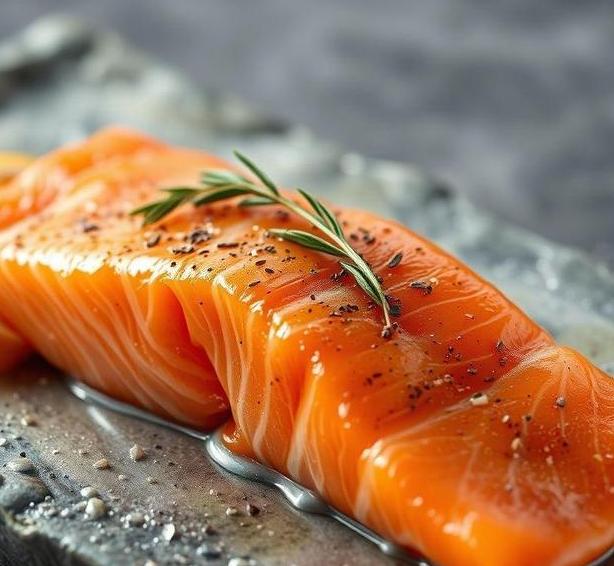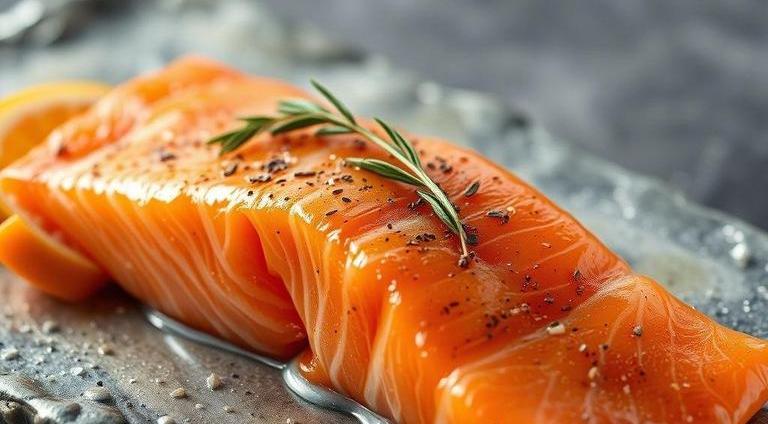Can Smoked Salmon Go Bad : What You MUST Know
Smoked salmon is a luxurious treat that brings sophistication to any meal, from bagels to appetizers, to adding a touch of decadence to your favorite salads or pasta dishes. Whether you’re a seasoned fan or a first-timer, smoked salmon has a rich, smoky flavor and delicate texture that makes it a staple in many households. But as with any perishable food, it’s important to understand how to handle it properly to ensure it stays fresh and safe to eat.
There’s always that lingering question-can smoked salmon go bad? Yes, it can, and unfortunately, it often happens if not stored correctly or consumed in time. This guide will take you through everything you need to know about the shelf life of smoked salmon, how to spot when it’s gone bad, the best ways to store it, and some expert tips to keep your smoked salmon tasting fresh longer.
Can Smoked Salmon Go Bad?
Smoked salmon, while preserved through the smoking process, is still a perishable product. Smoking can extend its shelf life by introducing an element of curing (through salt and smoke), but it doesn’t make the salmon immune to spoiling. Yes, smoked salmon can go bad, especially if it’s not handled or stored properly.
Here’s why:
- Moisture Content: Smoked salmon retains some moisture, which is an environment that bacteria love. Even though smoking reduces the growth of bacteria, it doesn’t eliminate the risk entirely.
- Perishability: Like any seafood, smoked salmon is made from fresh fish. This means it’s highly perishable, even though the smoking process does help preserve it for longer.
- Storage Conditions: Smoked salmon’s shelf life depends heavily on whether it’s kept under optimal conditions, such as in refrigeration or freezing. If left out too long, or if it’s not stored in an airtight container, it can easily go bad.
So while it’s a wonderfully indulgent food, it’s definitely something you need to manage with care, both during storage and while serving.
Shelf Life For Smoked Salmon

The shelf life of smoked salmon varies depending on whether it’s vacuum-sealed or not, and whether it’s kept refrigerated or frozen.
-
Vacuum-Sealed Smoked Salmon (Unopened)
- In the refrigerator: Vacuum-sealed smoked salmon, when unopened, can last for up to 2 to 3 weeks in the fridge, depending on its packaging and quality. Always check the sell-by or use-by date as a guideline.
- In the freezer: Freezing it will extend the shelf life to about 2 to 3 months. Freezing might alter the texture slightly, but it’s still safe to eat.
-
Opened Smoked Salmon
- In the refrigerator: Once you’ve opened the package, smoked salmon should be consumed within 3 to 7 days. After this period, the risk of spoilage increases significantly.
- In the freezer: If you decide not to finish the opened package, you can freeze the remainder for up to 1 month. However, for the best texture and flavor, it’s advised to consume it sooner.
- Homemade Smoked Salmon: The shelf life for homemade smoked salmon can vary based on the methods used and how well it’s stored. Generally, homemade smoked salmon will last in the fridge for about 1 to 2 weeks.
Common Signs Of Spoilage
Knowing the common signs of spoilage is critical, because sometimes we get busy and might not notice when things have gone wrong with our food. Here’s what to look out for when checking smoked salmon:
- Off or Sour Smell: Fresh smoked salmon has a clean, slightly briny, and smoky aroma. If it has gone bad, the smell will turn sour, fishy, or overly pungent. Trust your nose here-if it smells off, it’s better to err on the side of caution and discard it.
- Discoloration: Fresh smoked salmon has a bright, salmon-orange color. If the surface turns dull, grayish, or brown, this could indicate the start of spoilage. Small patches of discoloration aren’t unusual, but if the salmon looks off, it might be best to skip eating it.
- Slime or Stickiness: If the smoked salmon feels slimy or sticky to the touch, it’s a red flag. This could be a result of bacterial growth, and the texture should be firm and moist, not slippery. This is particularly evident when the product has been stored incorrectly.
- Change in Texture: Fresh smoked salmon should have a soft and tender texture, not overly mushy or tough. If it feels excessively dry or crumbly, this may suggest it’s no longer good to eat.
- Visible Mold: If you notice mold growing on the surface (which can sometimes appear as white or greenish spots), the salmon is spoiled. Mold can grow on foods that have been exposed to air for too long or stored in improperly sealed containers.
How To Store Smoked Salmon?

To get the most out of your smoked salmon and keep it safe for as long as possible, proper storage is essential. Here are the best practices:
-
Refrigeration
- Keep it airtight: Once you open the package, place your smoked salmon in an airtight container or wrap it tightly in plastic wrap or aluminum foil to prevent air exposure.
- Refrigerator temperature: Smoked salmon should always be kept at a consistent temperature of 38°F (3°C) or lower. This will slow down the growth of bacteria and maintain freshness.
- Avoid leaving it out: Don’t leave smoked salmon at room temperature for more than 2 hours. If the room is hot (over 90°F or 32°C), this window shrinks to 1 hour.
-
Freezing
- Wrap tightly: If you have extra smoked salmon that you can’t finish within the recommended fridge storage time, freeze it. Wrap it tightly in plastic wrap and place it in a freezer-safe, airtight bag or container. This will preserve its flavor and texture for up to 1 month.
- Portion it: Consider dividing the smoked salmon into smaller portions before freezing. This makes it easier to thaw only what you need and avoid refreezing leftovers, which can affect the texture and quality.
- Packaging: If you have unopened smoked salmon, ensure that the packaging is intact and airtight. Vacuum-sealed packaging is best, but if it’s in a regular sealed package, try to ensure it’s kept in a cool, dry place until you open it.
Expert Tips
Here are some pro tips to keep your smoked salmon fresh and tasty for longer:
- Use a Freshness Test: Before consuming smoked salmon, especially if it’s been in your fridge for a while, perform a simple freshness test. Smell it, check the texture, and give it a visual inspection. When in doubt, throw it out. It’s better to waste a little bit of salmon than risk foodborne illness.
- Know the Best Before Date: Always check the packaging’s best-before or use-by date before purchasing. If it’s near or past that date, consider picking another package to avoid the risk of spoilage.
- Rehydrate if Needed: If your smoked salmon starts to dry out, you can try rehydrating it slightly by placing it in a shallow dish and lightly covering it with water or a mild brine solution for a few minutes. This won’t restore it to its original texture but may improve the taste.
- Use it Quickly After Opening: Once you open a package, try to use the smoked salmon within the recommended time. If you can’t finish it in time, freezing it immediately will extend its life, but remember, once thawed, it should be eaten within a few days.
FAQs
Can Smoked Salmon Go Bad If Left Out?
Yes, smoked salmon can go bad if left out at room temperature for an extended period. It should not be left unrefrigerated for more than 2 hours to avoid the growth of harmful bacteria.
How Long Can Smoked Salmon Last In The Fridge?
Unopened smoked salmon can last up to 2 weeks in the refrigerator if stored properly. Once opened, it should be consumed within 5-7 days for the best quality and safety.
Can Smoked Salmon Spoil After Its Expiration Date?
Yes, smoked salmon can spoil after its expiration date, even if it is refrigerated. Always check for signs of spoilage such as off smells, discoloration, or a slimy texture before consuming.
What Are The Signs That Smoked Salmon Has Gone Bad?
Signs that smoked salmon has gone bad include an unpleasant odor, changes in color (e.g., from a pinkish hue to a grayish tone), slimy or sticky texture, and mold growth. Any of these signs indicate it should not be eaten.
Can Smoked Salmon Go Bad In The Freezer?
While smoked salmon can be frozen, its texture and flavor may degrade over time. If frozen, it’s best consumed within 3 months for optimal quality, but it remains safe to eat indefinitely if kept at a constant freezing temperature.
How Should Smoked Salmon Be Stored To Prevent It From Going Bad?
Smoked salmon should be stored in the refrigerator at 32°F (0°C), ideally in its original packaging. If opened, store it in an airtight container or tightly wrapped in plastic wrap to maintain freshness.
Can Smoked Salmon Be Eaten After The Sell-by Date?
Smoked salmon may still be safe to eat after the sell-by date, but it depends on storage conditions. Always inspect for signs of spoilage such as odor, discoloration, or a change in texture before consuming.
Is It Safe To Eat Smoked Salmon With An Off Smell?
No, it is not safe to eat smoked salmon with an off smell. A sour, rancid, or fishy odor indicates that the salmon has spoiled and should be discarded immediately.
What Happens If You Eat Spoiled Smoked Salmon?
Eating spoiled smoked salmon can lead to food poisoning, with symptoms such as nausea, vomiting, diarrhea, and stomach cramps. In severe cases, it can cause more serious health issues, particularly for vulnerable individuals.
Can Smoked Salmon Be Reheated After It’s Been Refrigerated?
Yes, smoked salmon can be reheated after being refrigerated. However, it is generally recommended to eat it cold or at room temperature to preserve its delicate texture and flavor. If reheating, do so gently to avoid drying it out.
